Swoyambhu Mahachaitya Temple Is A Must-Visit Destination In Kathmandu In 2025
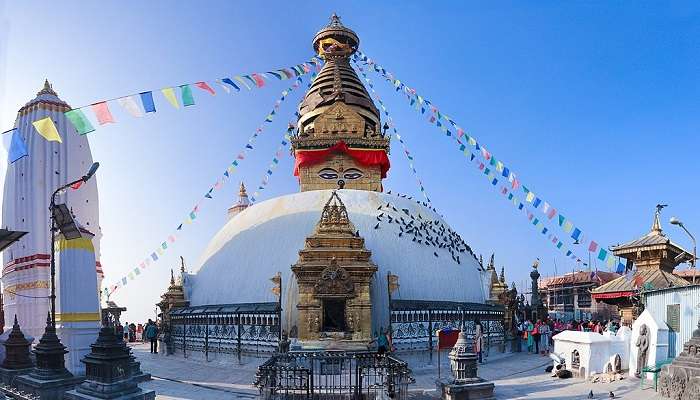
Did you know that the Swoyambhu Mahachaitya Temple, perched on a hilltop in the Kathmandu Valley, was naturally formed from a lotus flower? It is said that this sacred flower grew from a primordial lake and the light of the flower evolved into the stupa that is seen today. Also referred to as the Monkey Temple because of the freely roaming monkeys, Swoyambhu Mahachaitya is a rich history of culture, religion, and folklore. Whether you are a history lover, a religious person or an adventurer, this place is one of the most interesting and exciting places to visit.
Swoyambhu Mahachaitya Temple History
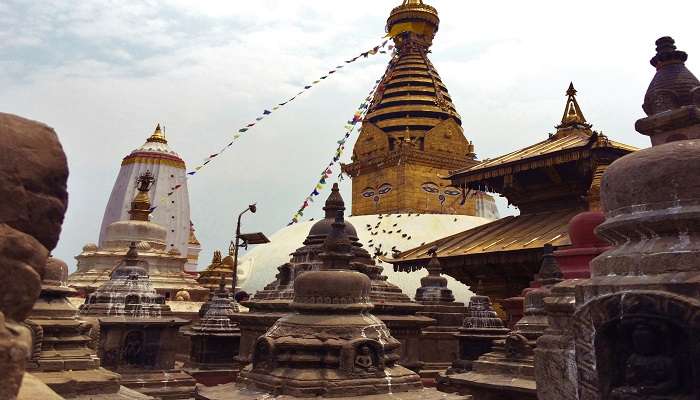
The history of Swoyambhu Mahachaitya Temple is filled with mythology. As per the Swayambhu Purana, the Kathmandu Valley was once a huge lake. A lotus flower bloomed from the water, and the light emitted from the flower was divine. Manjushri, the Bodhisattva of wisdom, scooped out the water with his sword and made the place accessible to human beings. The lotus then turned into the hill and the divine light into the stupa seen today.
Swoyambhu Mahachaitya Temple is one of the oldest religious sites in the country of Nepal. According to the historical evidence, the temple was built by King Vṛsadeva, who was the great-grandfather of Mānadeva, and the temple was built in the 5th century CE. It has been renovated many times over centuries; the latest major renovation was in 2010. The temple is of Buddhist architecture but is also respected by Hindus and, therefore, is an example of religious tolerance.
Must Read: Picnic Spots In Kathmandu
Architecture Of Swoyambhu Mahachaitya Temple
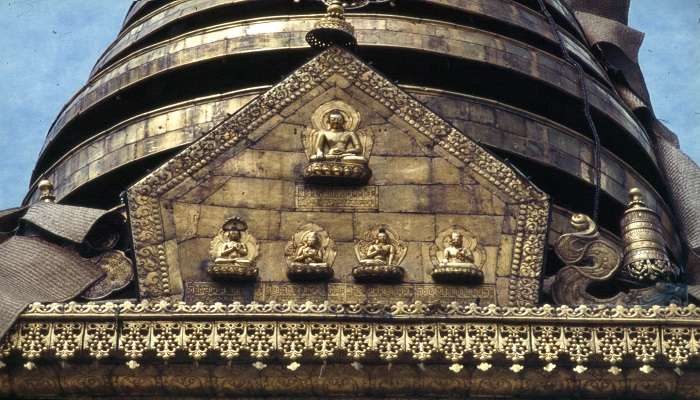
The main attraction of Swoyambhu Mahachaitya Temple is its large stupa. The stupa’s base is the lowest part, symbolising the earth and stability. On top of the base, there is a cube with paintings of Buddha’s eyes on all sides, symbolising wisdom and compassion. The spire is divided into thirteen sections, representing the thirteen steps one must go through to become a bodhisattva. At the top is a golden umbrella with a spire and a sequence of rings.
The architecture of the stupa is full of symbolism. The eyes of Buddha, also known as the Wisdom Eyes, are depicted to be looking in all directions to oversee the valley. Over each pair of eyes is a third eye which symbolizes the divine or the universal. The stupa is surrounded by prayer wheels containing the mantra “Om Mani Padme Hum” and the believers turn them to liberate prayers into the skies.
Experience The Swoyambhu Mahachaitya Temple
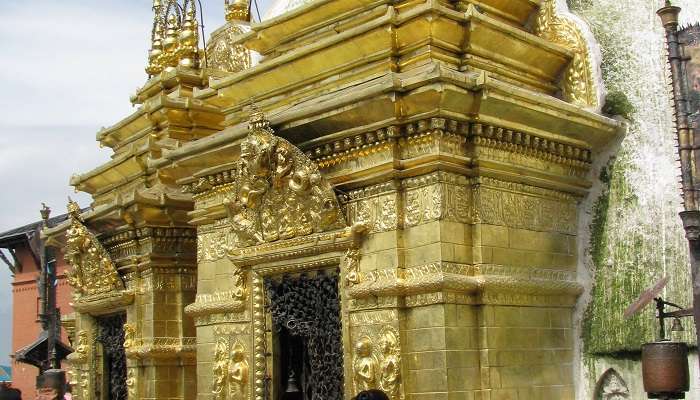
Pilgrims ascend the 365 steps to the temple at dawn, participating in clockwise circumambulations of the stupa believed to purify the soul. The sound of prayer wheels and the scent of incense create a serene atmosphere, perfect for introspection and prayer. Due to its association with Manjushri, the temple is home to numerous holy monkeys. These monkeys add a lively, albeit mischievous, charm to the temple complex. Visitors are advised to keep their belongings secure, as these curious creatures are known for their playful antics.
Suggested Read: Museums Of Nepal
Top Places To Visit Near Swoyambhu Mahachaitya Temple
One can find plenty of essential spots near the temple which are worth exploring. From the profound peaceful ambience of the Garden of Dreams to the spiritual essence of Boudhanath Stupa and the vibrant atmosphere of Thamel, the place of exploration is plenty.
1. Kathmandu Durbar Square
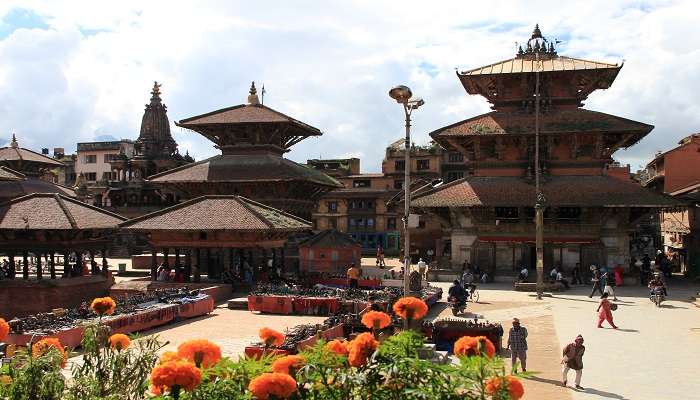
Kathmandu Durbar Square is the cultural and historical hub of Nepal, with numerous palaces, courtyards and temples. Visit the Hanuman Dhoka Palace, look at the beautiful carved wooden windows, and see the living goddess Kumari. The square is a World Heritage Site and a living cultural museum where people of Nepal come to live, work and play, and get a glimpse of the royal Nepal and its architectural marvel. This is where festivals and cultural events are conducted, so every time, they are different and interesting.
Distance from Swayambhu Temple Kathmandu: 2.2 km
Entry Fee: NPR 150 (INR 94) for SAARC nationals, NPR 1000 for other foreigners
2. Pashupatinath Temple

Pashupatinath Temple, one of the holiest Hindu shrines in the world, is dedicated to Lord Shiva. Located on the banks of the Bagmati River, the temple complex is a fascinating blend of religious ceremonies and daily life. Witness cremation rituals, explore the sacred ghats, and marvel at the stunning architecture adorned with intricate carvings and golden spires. The spiritual atmosphere and historical significance make Pashupatinath a must-visit for anyone in Kathmandu.
Distance from Swayambhu Temple Kathmandu: 7 km
Entry Fee: NPR 1000 for foreign nationals and all SAARC nationals except Indians
Suggested Read: Nepal Temples
3. Boudhanath Stupa
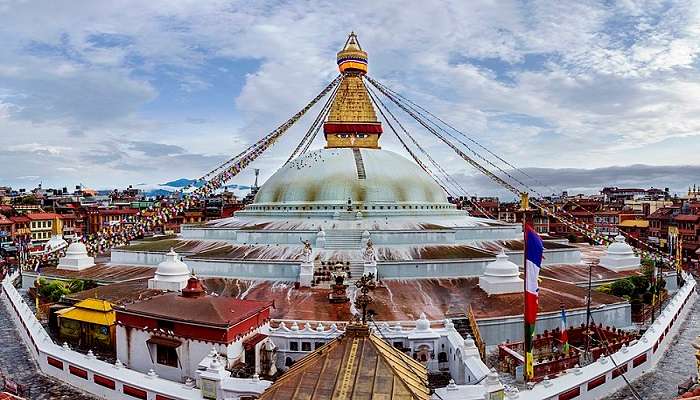
Boudhanath Stupa, another UNESCO World Heritage Site, is one of the largest stupas in the world and a centre of Tibetan Buddhism in Kathmandu. The massive mandala, adorned with colourful prayer flags, is surrounded by a vibrant community of monasteries, shops, and cafes. Join pilgrims in walking the kora (circumambulation) and soak in the peaceful atmosphere of this spiritual haven. The stupa’s serene environment offers a perfect spot for meditation and reflection.
Distance from Swayambhu Temple Kathmandu: 8.6 km
Entry Fee: NPR 400 for foreigners, NPR 100 for SAARC nationals
4. Garden Of Dreams
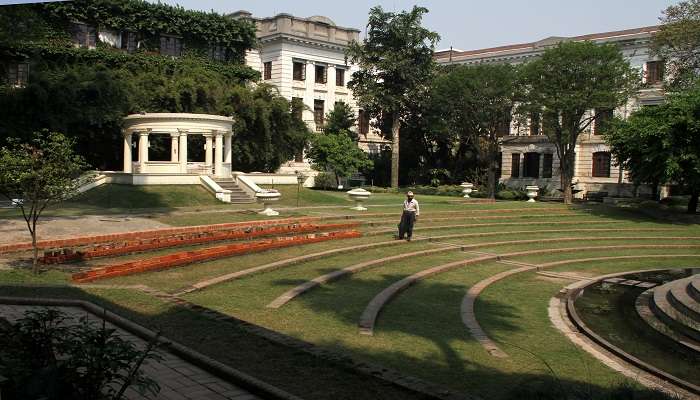
The Garden of Dreams is a neoclassical garden in the heart of Kathmandu, offering a tranquil escape from the city’s hustle and bustle. Designed in the 1920s, this serene oasis features pavilions, fountains, pergolas, and a variety of exotic plants. It’s a perfect spot for relaxation, reading, or enjoying a leisurely stroll amid beautifully landscaped surroundings. The garden’s elegant architecture and lush greenery provide a peaceful retreat from the urban chaos.
Distance from Swayambhu Temple Kathmandu: 3.3 km
Entry Fee: NPR 150 for Nepali and NPR 400 for Non-Nepali
Suggested Read: Hill Stations In Nepal
5. Thamel
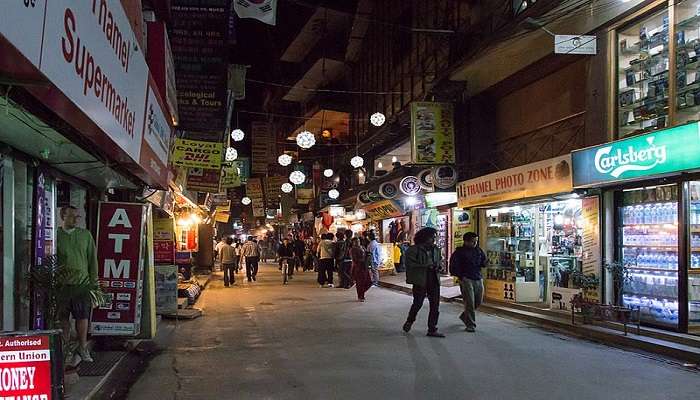
Thamel is Kathmandu’s bustling shopping destination, where you can buy almost everything from trekking gear to traditional handicrafts. It is also acknowledged for its electrifying and lively nightlife. Thamel is also a hub for travel agencies, making it an ideal place to plan and book your adventures in Nepal. The district’s dynamic atmosphere and variety of offerings make it a favourite among travellers.
Distance from Swayambhu Temple Kathmandu: 2.9 km
Entry Fee: Free entry
How To Reach Swoyambhu Mahachaitya Temple
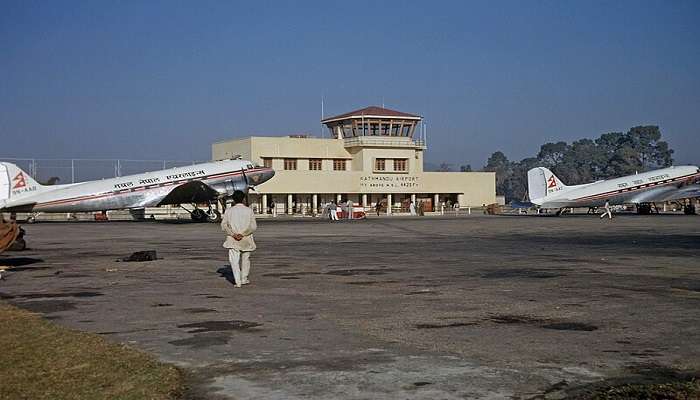
By Air
The nearest airport is Tribhuvan International Airport located in Kathmandu. After arriving at the airport, one can hire a taxi or take public transport to get to the temple.
By Road
Kathmandu has good road access to most of Nepal’s major cities. Local buses and taxis can take you to the base of the hill, where the temple is located.
By Rail
Nepal does not have a large railway system; however, tourists from India can take a train up to Gorakhpur and then take a road trip to Kathmandu.
Further Read: Places To Visit Near Kathmandu
Swoyambhu Mahachaitya Temple is not just a place to visit; it is a pilgrimage tour to the soul of Nepal. The temple is one of the most important religious sites in Nepal, and its architecture and history are truly breathtaking. Therefore, book a trip to Kathmandu to witness the enchanting blend of spiritual tranquillity and historical grandeur at this temple.
For our editorial codes of conduct and copyright disclaimer, please click here.
Cover Image Source: Nabin K. Sapkota for Wikipedia
Frequently Asked Questions About Swoyambhu Mahachaitya Temple
When is the best time to visit Swoyambhu Mahachaitya Temple?
It is recommended to visit the park either in the morning or in the evening when there are fewer people around.
Is there any possibility to have a guided tour in the temple?
Yes, it is possible to arrange for a guide to take you through the temple offering more information about the place.
Are there specific dress codes when going to the temple?
It is recommended that one dresses conservatively and avoid exposing the shoulders in consideration to the religious nature of the place.
Is it allowed to photograph inside the temple area?
Taking pictures is permitted but it is advisable to seek permission before taking pictures of the monks or religious activities.
What other places of interest are there near Swoyambhu Mahachaitya Temple?
Some of the nearby places of interest are Kathmandu Durbar Square, Boudhanath Stupa and Pashupatinath Temple.
People Also Read:
Masroor Rock Cut Temple Thien Hau Temple Karnak Temple

Get ready to wander the world through amazing visual tours that we provide via our blogs and stories. As a content writer, I love sharing incredible travel experiences that inspire readers to plan their own adventures and create unforgettable memories. From planning to execution, everything has already been served in these amusing tales. Let’s explore the world together, one destination at a time!











